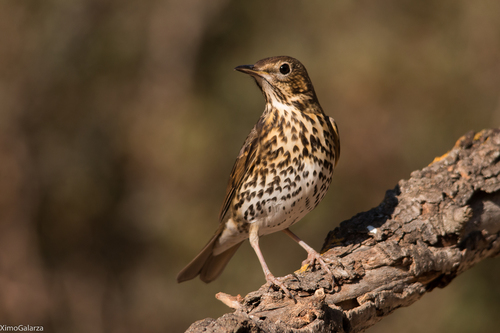
Song Thrush
The Song Thrush (*Turdus philomelos*) is a widely recognized and beloved songbird found throughout much of Europe, North Africa, and the Middle East. Known for its distinctive and melodious song, often delivered from a high, exposed perch, it plays a significant role in the soundscape of its habitat. Ecologically, it contributes to seed dispersal and insect control. Culturally, the Song Thrush has been featured in poetry and literature, often symbolizing spring and the beauty of nature.
20-23.5 cm
Length
33-36 cm
Wingspan
Least Concern
Conservation Status
Distribution
The Song Thrush breeds across a wide range of Eurasia, from Western Europe to Siberia. It is also found in North Africa and the Middle East. Northern populations are migratory, wintering in Southern Europe, North Africa, and the Middle East. Some populations have been introduced to New Zealand and Australia.
Lifespan
The average lifespan in the wild is around 3 years, but individuals can live up to 10 years or more.
Song Thrush's Habitat
Habitat Types
Woodlands, Gardens, Parks, Hedgerows, Farmland with trees
Climate Zones
Temperate, Boreal, Mediterranean
Adaptations
The Song Thrush is adaptable to a variety of habitats, provided there is sufficient cover for nesting and foraging. Its strong legs and bill are well-suited for foraging on the ground, and its ability to thrive in both natural and human-modified landscapes contributes to its wide distribution.
Variations
Several subspecies are recognized, including *T. p. philomelos* (widespread in Europe), *T. p. hebridensis* (Hebrides and Skye), and *T. p. clarkei* (British Isles and parts of Western Europe). These subspecies differ slightly in plumage coloration and size.
Appearance
Breeding Plumage
Plumage is generally similar year-round.
Seasonal Feather Changes
Minimal seasonal variation.
Sex Based Plumage Differences
Males and females have very similar plumage.
Notable Features
Warm brown upperparts., Creamy-white underparts with distinctive dark, drop-shaped spots., Buff-colored flanks., Relatively short tail.
Diet and Feeding
Primary Foods
Earthworms, Snails, Insects, Berries, Fruits
Foraging Behavior
The Song Thrush forages primarily on the ground, hopping and running to search for prey. It often uses a characteristic technique of running, stopping abruptly, and tilting its head to listen for earthworms. It is also famous for smashing snails on stones (called 'anvils') to break their shells.
Specializations
The use of 'anvils' (stones) to break snail shells is a learned behavior, demonstrating a degree of tool use. The bird's strong bill is well-adapted for handling a variety of prey items.
Seasonal Diet Variations
The diet shifts seasonally. During the breeding season, the Song Thrush relies heavily on invertebrates like earthworms and insects to feed its young. In autumn and winter, fruits and berries become a more significant part of the diet.
Behavior
Social Structure
Song Thrushes are generally solitary or found in pairs during the breeding season. Outside of the breeding season, they may form small, loose flocks, particularly during migration.
Communication
Complex and varied song, often incorporating mimicry of other bird species., Contact calls, including a sharp 'chook' and a thin 'seep'., Alarm calls, given when predators are detected.
Migration
Northern populations are migratory, traveling south for the winter. Migration is typically nocturnal. The timing and distance of migration vary depending on the population and the severity of the winter.
Territorial or Group Behaviors
Males establish and defend territories during the breeding season, using song and physical displays to deter rivals. Territories are typically small and centered around the nest site.
Conservation
Threats
Habitat loss and fragmentation (due to agriculture, urbanization, and deforestation)., Pesticide use (reducing invertebrate prey availability)., Climate change (affecting breeding success and migration patterns)., Predation (by cats, birds of prey, and other predators).
Protection Programs
Habitat restoration and management initiatives., Agri-environment schemes that promote biodiversity on farmland., Monitoring programs to track population trends.
Local National Laws
Protected under various national and international wildlife legislation, such as the EU Birds Directive.
Population Trend
Although the global population is considered stable, there have been significant declines in some regions, particularly in farmland areas of Western Europe.
Population Estimates
The global population is estimated to be 40-71 million mature individuals.
Interesting Facts
Song Thrushes are known for their ability to mimic other bird species.
Their complex song often incorporates phrases and calls borrowed from other birds in their environment.
They use stones as 'anvils' to break open snail shells.
This learned behavior is a remarkable example of tool use in birds.
Song Thrushes often return to the same breeding territory year after year.
This site fidelity demonstrates their strong attachment to specific locations.
The spots on a Song Thrush's breast are unique to each individual.
Like fingerprints, no two patterns are exactly the same.
Faqs about Song Thrush
What is the difference between a Song Thrush and a Mistle Thrush?
Mistle Thrushes are larger, have rounder spots on their breast (rather than drop-shaped), and a more upright posture. Their song is also different, being louder and more repetitive.
What should I do if I find a baby Song Thrush?
If the bird is uninjured and appears healthy, it is best to leave it alone. The parents are likely nearby and will continue to care for it. If the bird is injured or in immediate danger, contact a local wildlife rehabilitator. *Consult a professional for expert advice.*
How can I attract Song Thrushes to my garden?
Provide a variety of food sources, including berries, fruits, and mealworms. Ensure there is a source of fresh water. Plant shrubs and trees to provide cover and nesting sites. Avoid using pesticides.
Copyright @ Nature Style Limited. All Rights Reserved.
 English
English